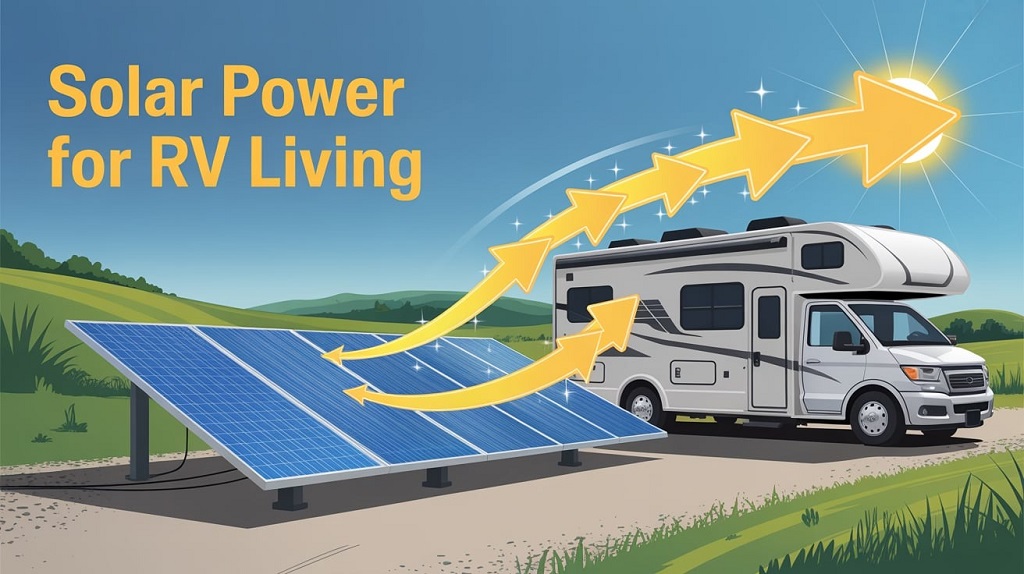How Much Solar Power Do I Need For My RV? The Ultimate Sizing Guide
You wake up to the sound of birds chirping outside your window, not an alarm clock. You’re parked on a remote BLM site with a million-dollar view, solar power for RV completely self-sufficient. Then you reach for the coffee grinder. Silence. You check your phone. 10%. A low battery warning flashes on your RV’s control panel. That dream of off-grid freedom suddenly feels out of reach, all because of a simple miscalculation not having enough solar power.
This scenario is the number one fear for aspiring and seasoned RV boondockers alike. The question “How much solar power do I need for my RV?” isn’t just about buying panels; it’s about buying your independence. Underestimate, and you’ll be constantly rationing power or listening to a generator. Overestimate, and you’ve wasted money and precious roof space.
This guide will cut through the confusion. We’ll walk you through a clear, step-by-step process to calculate your exact RV solar power needs, ensuring you can power your adventures without compromise.
Beyond the Sales Pitch: It’s Not About Watts, It’s About Watt-Hours
The biggest mistake beginners make is focusing solely on the size of the solar panel (e.g., “I have a 200-watt panel”). While panel wattage is important, it’s only one piece of the puzzle. The true measure of your energy system is your battery bank capacity, measured in amp-hours (Ah) or watt-hours (Wh).
Think of it this way:
- Solar Panel Watts: The speed at which you can fill your “energy bucket.”
- Battery Amp-Hours/Watt-Hours: The size of your “energy bucket.”
Your goal is to size your bucket (battery bank) to hold enough energy for your daily use and then size your hose (solar array) to refill it reliably, even on cloudy days.
Pro Tip: Convert everything to watt-hours (Wh) for the simplest math. It’s a universal measurement of energy.
- Formula: Amp-Hours (Ah) x Battery Voltage (V) = Watt-Hours (Wh)
- Example: A 100Ah 12V lithium battery has 100Ah x 12V = 1,200 Wh of energy.
Step 1: The Energy Audit – Calculating Your Daily Power Consumption
This is the most critical step. Precision here prevents pain later. Grab a notepad or a spreadsheet.
- List Every Electrical Device You Plan to Use: This includes lights, fans, water pump, phone chargers, laptops, routers, TVs, inverters (even their idle draw!), and especially power-hungry appliances like an Instant Pot, microwave, or air conditioner (though A/C on solar is a major challenge).
- Find its Power Draw in Watts: This is usually on a label on the device itself or in the manual. If it only lists amps, use this formula: Amps (A) x Volts (V) = Watts (W). (Assume 120V for AC appliances plugged into an inverter and 12V for DC appliances plugged directly into RV outlets).
- Estimate Daily Usage Time: How many hours per day will each device be running? Be realistic.
- Calculate Daily Watt-Hours for Each Device:
- Formula: Watts (W) x Hours Used (h) = Watt-Hours (Wh)
- *Example: A 12V DC Ceiling Fan (20W) running for 5 hours: 20W x 5h = 100 Wh.*
- *Example: A Laptop (60W) charged for 2 hours: 60W x 2h = 120 Wh.*
- For AC appliances running through an inverter, you must account for the inverter’s efficiency loss (about 10-15%). Multiply the result by 1.1 to be safe.
- *Example: Microwave (1,000W) used for 10 minutes (0.166 hours): 1000W x 0.166h = 166 Wh. 166 Wh x 1.1 (inverter loss) = ~183 Wh.*
Sample RV Power Audit Table:
| Device | Power (Watts) | Usage (Hours) | Daily Watt-Hours (Wh) |
| DC Ceiling Fan | 20W | 5 hours | 100 Wh |
| LED Lights (total) | 30W | 3 hours | 90 Wh |
| Water Pump | 40W | 0.5 hours | 20 Wh |
| Phone Charging | 10W | 2 hours | 20 Wh |
| Laptop Charging | 60W | 2 hours | 120 Wh |
| RV Refrigerator (LP mode uses DC for controls) | 30W | 24 hours (intermittent) | 720 Wh |
| Fantastic Fan | 30W | 4 hours | 120 Wh |
| TV (32″) via Inverter | 50W | 3 hours | 150 Wh (+15 Wh inverter loss) |
| Total Daily Consumption: | ~1,355 Wh |
This total daily consumption is your target. Let’s round it to 1,400 Wh for a buffer.
Step 2: Sizing Your Battery Bank to Meet the Demand
Your battery bank must store at least the amount of energy you calculated solar power for RV. However, you can’t fully drain most batteries.
- Lead-Acid Batteries (AGM/Gel): Only about 50% of their capacity is usable. Draining them further significantly shortens their lifespan.
- *Required Capacity for 1,400Wh: 1,400 Wh / 12V = ~117 Ah. 117 Ah / 0.5 (50% depth of discharge) = 234 Ah battery bank.*
- Lithium Iron Phosphate (LiFePO4) Batteries: The gold standard for RV solar. They offer 80-100% usable depth of discharge, are lighter, and last significantly longer.
- *Required Capacity for 1,400Wh: 1,400 Wh / 12V = ~117 Ah. 117 Ah / 0.8 (80% DoD) = 146 Ah lithium battery bank.*
For our example, a 200Ah lithium battery (which provides 200Ah x 12V = 2,400 Wh, with ~1,920 Wh usable) would be an excellent choice, offering a comfortable buffer.
Step 3: Sizing Your Solar Array to Replenish Your Batteries
Now, how do you refill those 1,400 Wh every day? This is where solar panels come in.
A solar panel’s rating (e.g., 100W) is its output under ideal lab conditions: bright sun, high in the sky, at a perfect angle. Real-world conditions are rarely ideal. Factors like clouds, heat, shading, and less-than-optimal angles dramatically reduce output. A good rule of thumb is to expect 4-5 hours of effective “peak sun” hours per day for calculation purposes.
The Formula:
Daily Watt-Hours Needed (Wh) ÷ Peak Sun Hours (h) = Minimum Solar Array Size (W)
- *Our Example: 1,400 Wh ÷ 4 h = 350 Watts of solar.*
Therefore, a 400-watt solar system would be a robust starting point for this energy budget, allowing for suboptimal weather.
Key Factors That Influence Your Solar Needs
Your final calculation isn’t just about math. You must consider these variables:
- Weather and Season: Sun hours drop significantly in winter and in consistently cloudy regions (like the Pacific Northwest). If you camp year-round, size for the worst season.
- Shade: Parking under trees makes panels useless. If you love forested campsites, you need more panels to capture dappled light or a generator backup.
- Roof Real Estate: How much physical space do you have? Modern high-efficiency panels can squeeze more watts into a smaller area.
- The 12V vs. 120V AC Rule: Using an inverter to power AC appliances is inefficient. Whenever possible, use DC versions or find 12V alternatives (e.g., a 12V TV or a USB-C monitor).
- The “Big Draw” Appliances: Air conditioners are the ultimate power hog. Running a 13,500 BTU A/C unit requires a massive solar array (1,000W+), a huge battery bank (600+ Ah lithium), and a large inverter. Most consider this impractical, relying instead on generators or campground shore power for cooling.
Here’s a quick guide to typical system sizes based on travel style:
- Weekender (Basic Power User): Powers lights, water pump, charges phones, runs a fan.
- Battery: 100-200Ah Lithium or 200-300Ah Lead-Acid
- Solar: 200-300 Watts
- The Boondocker (Moderate Power User): Powers everything above plus a laptop, efficient 12V TV, stereo, and occasional small appliance.
- Battery: 300-400Ah Lithium
- Solar: 400-600 Watts
- The Full-Timer (High Power User): Powers all modern conveniences, larger inverters, and may attempt to run a microwave or coffee maker regularly.
- Battery: 600Ah+ Lithium
- Solar: 800-1,200+ Watts (often with a generator backup)
Don’t Forget the Supporting Cast: Charge Controller and Inverter
Your solar panels are useless without a quality solar charge controller (either PWM or more efficient MPPT) to regulate the power going into your batteries. For any system over 200W, an MPPT controller is highly recommended for its superior efficiency.
If you need to power standard household plugs (AC), you’ll need an inverter. Size it based on the highest-wattage appliance you’ll run simultaneously.
Read More Also: Cute And Casual Winter Outfits For Women
Conclusion: Your Path to Energy Freedom Starts with a Calculation
Figuring out “how much solar power do I need for my RV” isn’t a guess. It’s a deliberate process of understanding your own energy habits and building a system to match them. By starting with an honest energy audit, sizing your battery bank correctly, and then choosing a solar array that can keep up, you invest in more than just gear—you invest in the freedom to go wherever the road takes you, confident that your coffee will be hot and your lights will be on.
Discover More: Luxury Handbags for Women in 2025














Post Comment